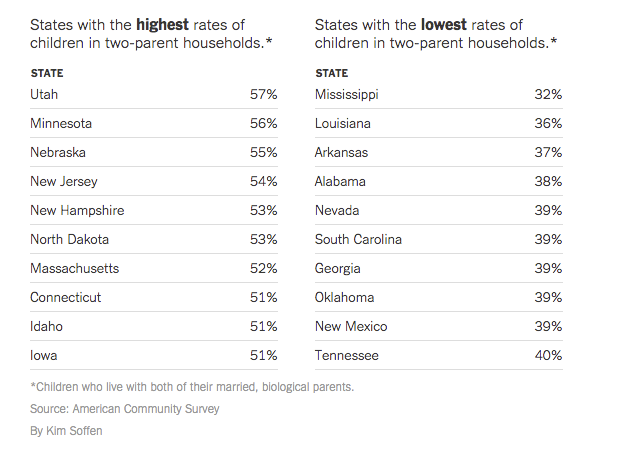Check out the above. It’s a map of two-parent households around the USA, as organized by percentage of states. If you want a better version, click here. If you’re into lists of states and percentages, well, here you go:
This is a complicated issue to discuss socially because many single-parent homes are heroic in many respects, so having two parents around doesn’t necessarily mean you’re going to be better off, no. The general idea, though, is that more upward mobility results when you have two parents around.
Now look at the right column of the second graphic — Mississippi, Louisiana, Arkansas, Alabama, South Carolina, Georgia, etc. It’s basically the SEC, football-wise. It’s the American Southeast and then some “Sun Belt” states like Nevada, New Mexico, and Oklahoma. (Oklahoma probably isn’t Sun Belt to most people, but it’s hot as hell, so I’ll call it that for right now.)
Here’s the problem: those places with the lowest rate of two-parent households also have the lowest rates of social mobility.
You get put in a dark, circular loop here: areas with less two-parent families are also producing children with less upward social opportunities, which continues the pervasive notion/cycle of inequality. And this isn’t just necessarily a divorce issue. To wit:
And they are, on average. But the new paper argues that the situation also has some important nuances. Above all, divorce is no longer the main reason that children do not grow up with both of their parents. Divorce has declined in recent years. So, however, has marriage, while single parenthood — and the number of children who never live with both parents — has risen sharply. Marriage and single parenthood don’t break down along the same red-blue lines that divorce does.
Another point to note: the low percentage of two-parent families states tend to be red states with lower commitment to education or blue states with average commitment to education; you’ll almost never find an education-forward red or blue state on this list. Whether that’s causative or correlative, I can’t 100 percent tell you. I can tell you education is clearly important. It’s a shame we continue to make it a political issue, though.


